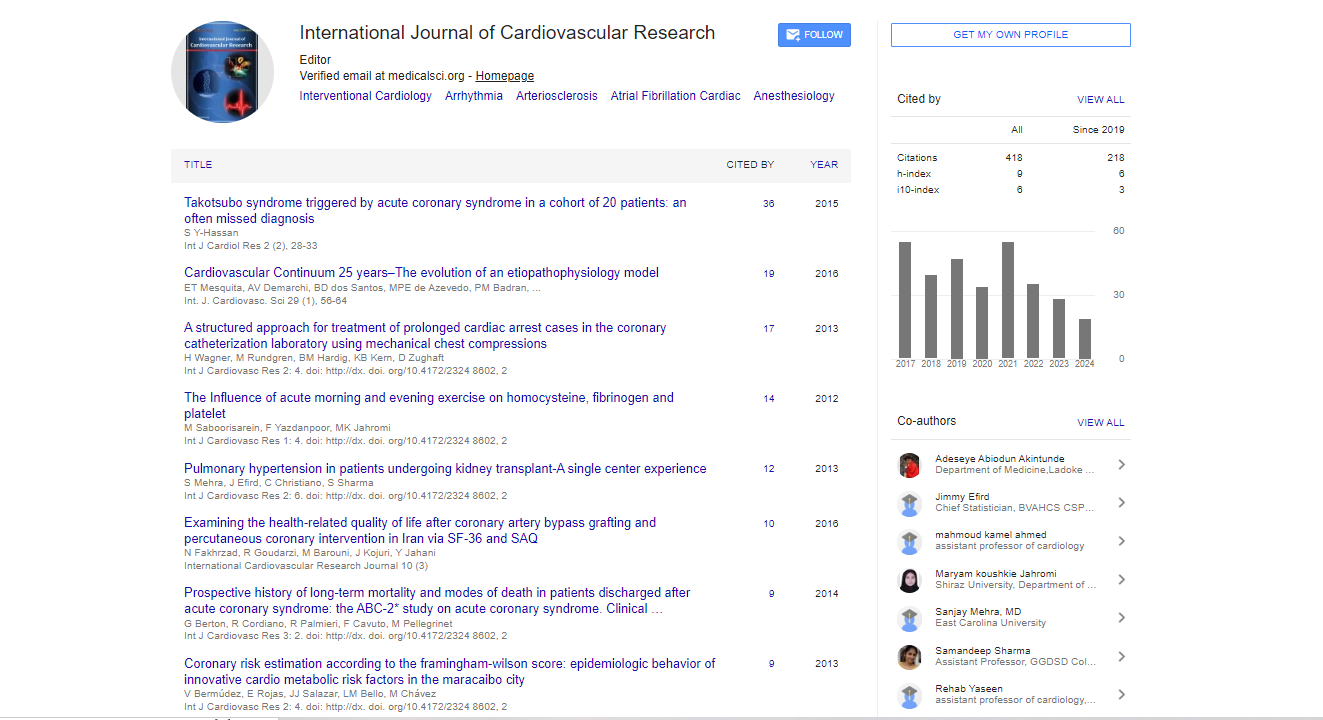Commentary, Int J Cardiol Res Vol: 13 Issue: 6
Coronary Angiography and Cardiac Catheterization in Acute Coronary Syndrome
Esme Kensington*
Department of Pediatrics, Sungkyunkwan University, Seoul, South Korea
- *Corresponding Author:
- Esme Kensington
Department of Pediatrics,
Sungkyunkwan University,
Seoul,
South Korea;
E-mail: esme.kensington@su.kr
Received date: 07 November, 2023, Manuscript No. ICRJ-23-119410;
Editor assigned date: 09 November, 2023, PreQC No. ICRJ-23-119410 (PQ);
Reviewed date: 23 November, 2023, QC No. ICRJ-23-119410;
Revised date: 16 December, 2024, Manuscript No. ICRJ-23-119410 (R);
Published date: 23 December, 2024, DOI: 10.4172/2324-8602.1000592
Citation: Kensington E (2024) Coronary Angiography and Cardiac Catheterization in Acute Coronary Syndrome. Int J Cardiol Res 13:6.
Description
Acute Coronary Syndrome (ACS) is a life-threatening condition characterized by the sudden, reduced blood flow to the heart muscle. It encompasses a spectrum of cardiac events, ranging from unstable angina to Non-ST-segment Elevation Myocardial Infarction (NSTEMI) and ST-segment Elevation Myocardial Infarction (STEMI). Prompt diagnosis and intervention are vital for ACS patients to prevent further damage to the heart. Coronary angiography and cardiac catheterization are essential procedures in the management of ACS, as they provide important information and allow for therapeutic interventions that can save lives.
The role of coronary angiography
Coronary angiography is a diagnostic procedure that involves injecting a contrast dye into the coronary arteries to visualize blood flow and assess the patency of the vessels. It is a vital tool in the evaluation of ACS for the following reasons:
• Coronary angiography allows clinicians to identify stenotic or
occluded segments within the coronary arteries, which may be
responsible for the patient's chest pain or other ACS symptoms. It
helps distinguish between NSTEMI and STEMI.
• Coronary angiography provides information about the location,
number, and severity of coronary artery blockages, helping
determine the extent of coronary artery disease.
• The information obtained from coronary angiography guides the
selection of appropriate therapeutic interventions, including
Percutaneous Coronary Interventions (PCI) such as angioplasty and
stent placement or Coronary Artery Bypass Grafting (CABG).
The role of cardiac catheterization
Cardiac catheterization is the invasive procedure used to perform coronary angiography. It involves inserting a thin, flexible catheter into an artery or vein, typically through the femoral or radial artery, and advancing it to the coronary arteries. Cardiac catheterization serves several vital functions in ACS management:
The catheter allows real-time visualization of the coronary arteries, enabling the cardiologist to assess blood flow, identify lesions, and determine the appropriate course of treatment.
Cardiac catheterization can measure pressures within the heart chambers and blood vessels. This information is essential for evaluating cardiac function and diagnosing conditions like cardiogenic shock.
Beyond diagnosis, cardiac catheterization enables therapeutic interventions like angioplasty and stent placement. In the case of STEMI, rapid primary PCI is the standard of care to open the blocked artery and restore blood flow to the heart muscle.
Distinguishing NSTEMI and STEMI
Both NSTEMI and STEMI are subsets of ACS, but they have important differences in their presentation and management:
In NSTEMI, there is partial blockage or non-occlusive thrombus in one or more coronary arteries. The Electrocardiogram (ECG) typically shows ST-segment depression or T-wave inversion. Coronary angiography helps identify the culprit lesion and guides treatment decisions, often involving coronary stent placement if indicated.
In STEMI, there is complete occlusion of a coronary artery, leading to a transmural myocardial infarction. The ECG shows characteristic ST-segment elevation. Rapid reperfusion through primary PCI or thrombolytic therapy is the cornerstone of STEMI management. Coronary angiography is performed immediately to identify the blocked artery and guide intervention.
Clinical significance and guidelines
The role of coronary angiography and cardiac catheterization in ACS management is supported by evidence-based guidelines and consensus recommendations. Key points to consider include:
• For patients with STEMI, immediate coronary angiography and
primary PCI within 90 minutes of presentation are recommended. In
NSTEMI, an early invasive strategy is often preferred within 24-48
hours for higher-risk patients.
• Selection criteria for invasive strategies are based on clinical risk
assessment, including factors like troponin levels, ECG findings,
and patient stability.
• The choice between femoral and radial access for cardiac
catheterization depends on individual patient characteristics and
operator experience. Radial access has gained popularity due to its
lower risk of bleeding complications.
• In some cases, thrombus aspiration may be used in primary PCI to
remove thrombotic material from the coronary artery, facilitating
reperfusion.
• Drug-Eluting Stents (DES) are commonly used in PCI to reduce the
risk of restenosis, while bare-metal stents may be preferred in
certain situations.
Conclusion
Coronary angiography and cardiac catheterization are indispensable procedures in the management of acute coronary syndrome. They provide essential diagnostic information, enabling clinicians to identify the location and severity of coronary artery lesions. Moreover, these procedures allow for life-saving therapeutic interventions, such as angioplasty and stent placement, in a timely manner. The timing and selection of these interventions are guided by established guidelines and the patient's clinical presentation.
ACS is an acute condition that demands swift and precise intervention. The use of coronary angiography and cardiac catheterization, in conjunction with medical therapy, has significantly improved the outcomes and prognosis of ACS patients. These procedures underscore the importance of a multidisciplinary approach involving cardiologists, interventionalists, and healthcare teams to ensure the best possible care for individuals facing this life-threatening condition.
 Spanish
Spanish  Chinese
Chinese  Russian
Russian  German
German  French
French  Japanese
Japanese  Portuguese
Portuguese  Hindi
Hindi 



